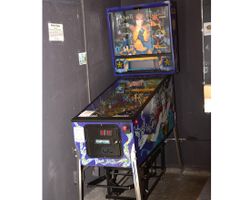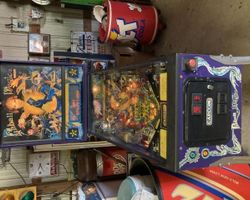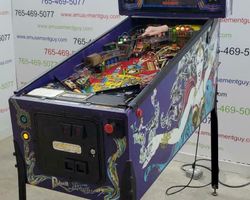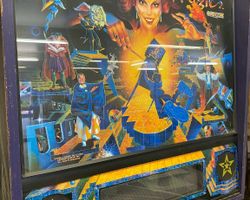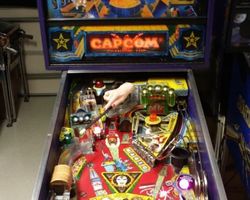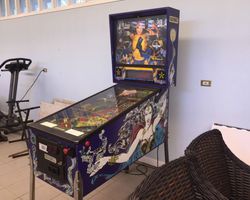Pinball Magic
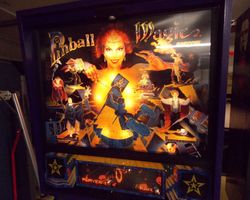
Average Prices: USD $800 to $3,600
Produced: October, 1995
Production Run: 1,200 units
Machine Type: Solid State Electronic
MPU: Capcom A0015405
Players: 4
Design by: Rob Hurtado, Bryan Hansen
Art by: Jeff Busch, Hugh Van Zanten
Dots/Animation by: Scott Pikulski
Mechanics by: Michael Zhang, Rick Morgan
Music by: Chris Granner, Jeff Powell
Software by: Sammy Zehr
Capcom Coin-Op, Incorporated made its foray into the pinball arena with a distinct vision, aiming to carve out its own niche in a competitive market. In October 1995, one of their notable creations, "Pinball Magic," entered the scene. This solid-state electronic machine, bearing the model number PBM3000, was designed to captivate players with an elaborate magic show theme, a departure from the typical licensed properties prevalent in the era. The inspiration was clear: to immerse players in a grand illusion, filled with sleight of hand and fantastical feats.
The genesis of Pinball Magic involved a collaborative effort from a dedicated team. The core design was conceived by Bryan Hansen and Rob Hurtado, who together laid the conceptual groundwork for the game's innovative play. Sammy Zehr was responsible for the software, translating the mechanical and conceptual designs into responsive gameplay logic. The visual identity of the machine came to life through the artistic talents of Hugh van Zanten and Jeff Busch, who crafted the distinct artwork. Sound and music, crucial for setting the mystical atmosphere, were developed by Chris Granner and Jeff Powell. Michael Zhang and Rick Morgan handled the mechanics, ensuring the intricate physical features functioned seamlessly, while Scott Pikulski animated the dot matrix display sequences. With a production run of 1,200 units, Pinball Magic demonstrated Capcom's commitment to delivering a unique pinball experience, showcasing their engineering prowess and creative ambition. One notable aspect of its design is the number of patents associated with the machine, reportedly more than any other pinball game, underscoring its mechanical innovation.
Signature Features and Design
Pinball Magic distinguishes itself through a collection of unique mechanisms and visual flair that are central to its magic show theme. Foremost among these is the "Magic Wand," a magnetic ball diverter positioned above the left ramp. This mechanism isn't merely decorative; it actively carries the ball along its length, guiding it to various locations on the playfield, most notably feeding it directly to the Magic Trunk for ball locks. This dynamic manipulation of the ball enhances the sense of being part of an illusion.
Another impressive feature is the "Ball-Levitating Stage" within the "Showtime Stage" area. A hidden mechanism lifts a ball into plain sight, creating the illusion of it floating in the air. This moment is designed to be a visual spectacle, synchronized with the game's objectives and lighting effects, enhancing the overall magical ambiance. The "Magic Hat" serves as a distinctive plunger skill shot, inviting players to precisely plunge the ball into its opening to initiate various bonuses or game modes.
The machine’s cabinet boasts a custom shape, immediately setting it apart visually from standard designs. The playfield integrates several interactive elements, including a "Crystal Ball" stand-up target and the "Star Bumper" nestled within an action ring, adding to the dynamic visual landscape. These signature features are not isolated gimmicks but are woven into the gameplay, requiring player interaction and contributing to the machine’s captivating and unique identity.
Playfield and Mechanics
The playfield of Pinball Magic is meticulously designed to support its magical theme, guiding players through a series of "tricks" and challenges. At the heart of the layout are the two flippers, positioned to control the ball's trajectory across a well-appointed playing surface. Key shots include the Scoop, often referred to as the "Genie bottle," which acts as an entry point for timed choices and bonus points. The "Magic Trunk" serves as a crucial ball lock mechanism, essential for initiating multiball play.
A set of five drop targets spelling "M-A-G-I-C" present a clear objective for players to aim for. Adjacent to these, the "Morph Chamber" houses three stand-up targets; completing these is vital for activating certain features, including the "Reappearing Ball" kickback in the left outlane, offering a temporary ball save.
The layout features a single ramp, the "Secret Passageway," which, when shot, diverts the ball to a right habitrail or, notably, to the magnetic Magic Wand. This integration of the ramp with the Magic Wand exemplifies the game's flow, as the wand then guides the ball, often to the Magic Trunk for ball locks, creating a cohesive and satisfying shot sequence. The "Linking Rings" loop provides a continuous flow shot around the upper playfield.
The "Showtime Stage" mini-ramp, a target for increasing "Box Office points," culminates in a timed target-hitting frenzy. A single pop bumper, the "Star Pit," adds a chaotic element to the upper playfield. The aesthetic of the playfield is vibrant, though some feedback points to an abundance of red in the artwork, potentially reducing visual contrast in certain areas. However, the lighting system is a strong point, with computer-controlled effects that enhance the magical atmosphere, highlighting targets and pathways as gameplay progresses. The overall design philosophy emphasizes clear objectives and a linear progression, creating a sense of a structured magic show.
Gameplay Dynamics
Pinball Magic's gameplay unfolds as a sequence of magical acts, structured around a three-round progression, each culminating in a "grand finale"-like scoring feature. The initial stages of the game task players with hitting specific shots to "impress magicians," progressively unlocking further challenges. The "Magic Hat" skill shot, a direct plunge into the hat, offers immediate bonus points or activates "Mayhem" when lit, providing an early strategic choice.
Multiball, known as "Magic Mayhem," is initiated by striking all three Morph targets and then locking one or two balls in the "Magic Trunk." During this high-energy mode, the objective shifts to earning "Jackpots" by successfully hitting the left ramp, followed by a shot up the right loop to start a timed jackpot build. This sequence demands precision and quick reflexes from the player.
The "Genie Bottle" scoop offers a unique interactive element, presenting timed choices that can lead to significant bonus points, encouraging players to consider their options under pressure. The "Showtime Stage" ramp, when repeatedly struck, increases "Box Office" points and can trigger a timed target-hitting frenzy, where players race against the clock to hit illuminated targets for escalating scores. The "Secret Passageway" ramp, intertwined with the Magic Wand, frequently funnels balls towards the Magic Trunk, centralizing multiball preparation. The "Crystal Ball" target requires hitting it and then hitting it again when a matching color is lit for substantial points, adding a memory-based element. "Amateur Hour" is initiated by hitting the captive ball, lighting the Showtime and Star Pit targets for high scores based on a timer. The game’s design leans towards a linear ruleset, where players progress through distinct objectives rather than an open-ended, complex rule structure. While some find this linearity repetitive, many appreciate the clear goals it provides, making the game accessible yet challenging.
Reception and Legacy
Pinball Magic arrived in the mid-1990s, a period of intense innovation and competition within the pinball industry. Its reception within the pinball community has often been characterized by a consensus that it is an "underrated" machine, particularly when compared to other magic-themed games from the era. Its unique toys and innovative mechanisms are frequently cited as primary strengths. The magnetic "Magic Wand" and the "Levitating Ball" on the Showtime Stage consistently receive praise for their visual impact and integration into gameplay, showcasing Capcom's willingness to push mechanical boundaries. The custom cabinet art is also well-regarded, contributing to the machine's distinctive presence.
However, feedback is not without its criticisms. The playfield art is sometimes described as being too red or lacking in intricate detail, which some players found visually uninspiring compared to the cabinet art. While the sound quality is generally considered good, some players found the overall music and sound effects to be a weaker aspect. The linearity of the ruleset, while appreciated by some for its clear objectives and progression, was viewed by others as limiting the game's long-term variety and replayability. Furthermore, as a Capcom machine, parts availability has always been a practical concern for owners, potentially impacting maintenance and restoration efforts.
Despite these points of contention, Pinball Magic’s legacy is marked by its innovative spirit and unique mechanical features. Its advanced diagnostic capabilities were a forward-thinking element, aiding in troubleshooting and maintenance. The game is often discussed in direct comparison to other magic-themed pinball machines, with many players asserting that Pinball Magic offers superior gameplay and innovation, sometimes at a more accessible value. It stands as a testament to Capcom Coin-Op's bold approach to pinball design, demonstrating that original concepts could compete with licensed themes by focusing on groundbreaking physical interactions and a cohesive thematic experience. Its continued appreciation among collectors and enthusiasts stems from its engaging gameplay, challenging shots, and the undeniable charm of its magical illusions.
Sponsored Links
 Ebay Listings
Ebay Listings
 Auction Results
Auction Results
| Cost | Location | Date |
|---|---|---|
| USD $4,300 |  California, United States California, United States |
20 February, 2025 |
| USD $1,000 |  Michigan, United States Michigan, United States |
30 June, 2024 |
| USD $8,000 |  Oklahoma, United States Oklahoma, United States |
19 June, 2024 |
| USD $2,500 |  Florida, United States Florida, United States |
23 March, 2024 |
| USD $5,500 |  Utah, United States Utah, United States |
03 January, 2024 |
| USD $5,350 |  Colorado, United States Colorado, United States |
08 August, 2022 |
| USD $5,550 |  Indiana, United States Indiana, United States |
12 February, 2022 |
| USD $5,000 |  Texas, United States Texas, United States |
21 January, 2022 |
| USD $5,550 |  Indiana, United States Indiana, United States |
31 December, 2021 |
| AUD $4,252 |  Queensland, Australia Queensland, Australia |
16 December, 2021 |


Private Policy · Search Website · Contact Us
As an eBay Partner, we may earn a commission from qualifying purchases made through links on this site, at no additional cost to you.
All trademarks and copyrighted materials remain property of their respective owners. All other content copyright 2007 - 2025 Pinpedia.

